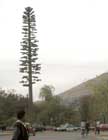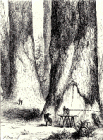Topics
A Rationale for the Gymnosperm Database
Database Field Descriptions, in which I tackle such prickly questions as "what is a species?" and explain why the Database doesn't tell you where to find big trees.
Review of the Gymnosperm Literature, last revised late 2013, a useful guide to where to look for information I haven't yet posted online.
The Future of Washingtons' Forests. This was an invited talk I gave to the Washington Native Plant Society in November, 2022, discussing climate change and other factors that will influence the fate of Washington's forests during the remainder of the 21st century. It shows some significant evolution beyond the similar April-2022 talk.
Future Forests of Washington. In April 2022 I gave a presentation on this topic to the Washington Native Plant Society, and this is a video recording of that presentation. Climate change poses an existential threat to many of the world's forests, through mechanisms that include extreme heat, drought, invasive pests and pathogens, dramatic increases in fire size and severity, and trees' inability to migrate across the landscape fast enough to keep up with the changing climate. This presentation looks at those risks for the Pacific Northwest, but these lessons apply to conifers across most of the globe. Unfortunately there were some technical problems so I have also posted a copy of the presentation here (15 MB file).
Big and Old Trees
Vegetative Reproduction in Conifers and Ginkgo. An ongoing compilation of which conifer species reproduce by epicormic budding, suckering, and layering.
Conifer Longevity. This is the transcript of a talk I gave on 2010.06.11 at the Pinetum Blijdenstein (Netherlands), at the release of Aljos Farjon's new book, A Handbook of the World's Conifers. It discusses the biological basis of longevity in conifers, and presents some of the oldest known trees.
Tree Age Determination, and Roster of the Ancients. This was reprinted by the native plant societies of British Columbia, Washington and Oregon.
Tree Size Determination, and A Tale of Big Tree Hunting In California
Geographic Regions
Conifers of eastern North America
Conifers of western North America
Gymnosperms of Alta California
Conifers of Mexico
Gymnosperms of New Caledonia
Gymnosperms of Sichuan
Gymnosperms of Australia
Conifers of New Zealand
Phylogeny of East Asian white pines
Conifer Hunting In Central Mexico (2005). This is mainly a travelogue with a lot of tree photos (mostly Pinus and Taxodium).
Conifer Hunting In Northern Mexico (2007). It has a strong emphasis on the motorcycle trip aspect of it—this piece was written for the local BMW riders club newsletter. However, I've also included a transcription of the trip notes, which are heavy on conifer info.
PDF file: Forest Dynamics In A Forest-Tundra Ecotone, Medicine Bow Mountains, Wyoming. This is the text of my 1993 dissertation, which people sometimes request copies of. Link opens in a new window.
History of Botany
Latin: Why do all the plants have Latin names?
Great Conifer Botanists: A review of the history of collecting, publishing, and compiling accounts about conifers, including brief biographical sketches of the most significant conifer botanists active in the historic era, and the most important published compilations of conifers from the time of Linnaeus to the present.
Journal kept by David Douglas during his travels in North America 1823—1827. This is the 1914 publication of one of the great plant-hunting accounts, by the man who discovered or described many of the great conifers of Washington, Oregon, and California. Right-click HERE to download a copy (PDF, 25 MB).
Thaddeus Haenke and the Coast Redwoods
Biographical sketch for George Engelmann (1809-1884), New World botanist
Biographical sketch for Thomas Kirk (1826-1898), New Zealand botanist.
Biographical sketch for Robert P. Adams (1939-2020), "Mr. Juniper."
Miscellany
Forest Bathing. Recent studies show that this historically Japanese practice, which simply involves meditative time spent in a peaceful conifer forest, yields a variety of unexpected health benefits.
Gymnosperm Beer. Historically, beer was important on long sea voyages as a (relatively) antiseptic beverage and, if flavored with spruce tips, an anti-scorbutic. Today, conifers are featured in many popular craft beers. This page collects some labels and logos from those brews.
Conifers in United States Place Names. There are over 25,000 places in the U.S. that take their names from conifers.
Breeding Systems in Gymnosperms -- Relative Benefits and Costs of Being Monoecious or Dioecious
Uses of Conifer Wood in Musical Instruments
Why Do Trees Form Spiral Grain?
Anser pseudarboris, the Christmas Tree
Just for fun.
Phytophthora, one of the deadliest pathogens in the conifer world.
White Pine blister rust, one of the deadliest pathogens in the pine world.
Recent Notes on the Database. This is the 'news' page, but it's updated quite sporadically.
Online Interview with Mary Townsend, editor of Amazing Trees, a webzine
Alphabetical Index of All Taxa On This Website
Ciesla, William M. 1998. Non-wood forest products from conifers. FAO. https://www.fao.org/3/x0453e/x0453e.pdf, accessed 2021.12.21. The chapter on "Conifers in Human Culture" is particularly interesting.


